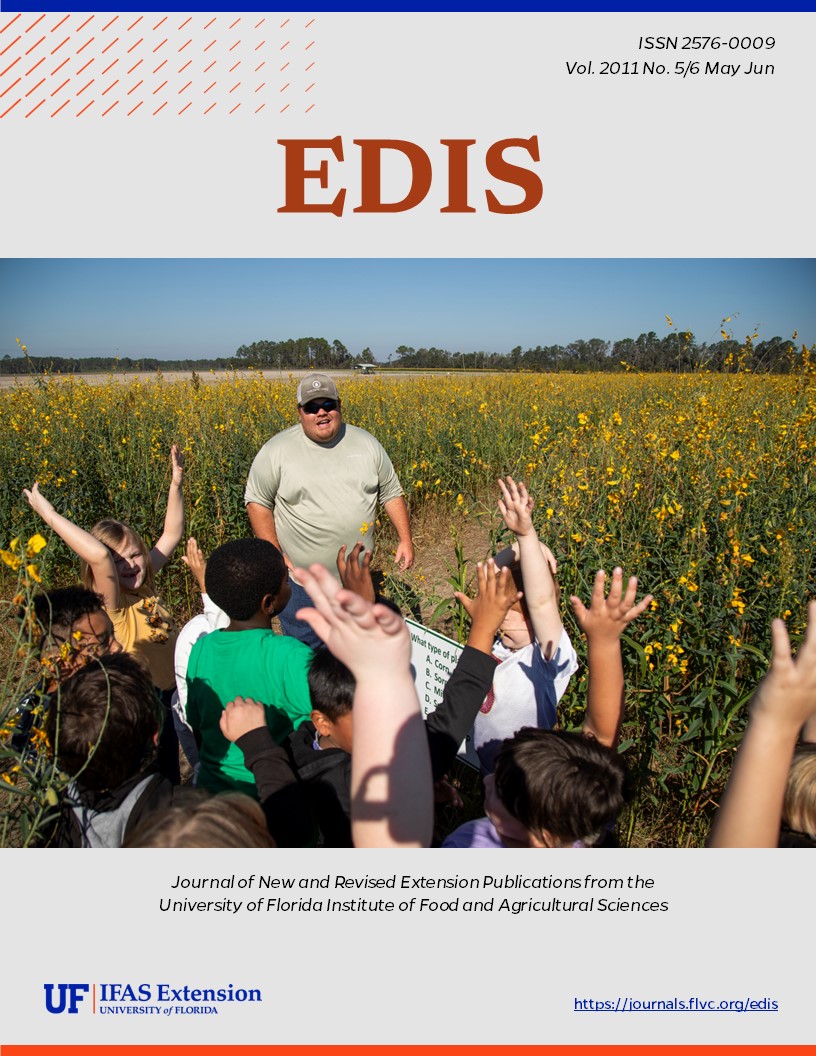Abstract
Benghal dayflower is an increasingly problematic weed that is federally designated as a noxious weed. This revised 10-page fact sheet provides nursery owners how to prevent, detect, and eradicate this invasive plant. Written by Robert Stamps and published by the UF Department of Environmental Horticulture, May 2011.
References
Budd, G. D., P. E. L. Thomas, and J. C. S. Allison. 1979. "Vegetative Regeneration, Depth of Germination and Seed Dormancy in Commelina benghalensis L. Rhodesian." J. Agric. Res.17:151-153.
Carvalho, S., A. Dias, V. Damin, M. Nicolai, and P. Christoffoleti. 2008. "Glyphosate Applied with Different Concentrations of Urea or Ammonium Sulfate for Weed Desiccation." Pesquisa Agropecuaria Brasileira 43:1501-1508. https://doi.org/10.1590/S0100-204X2008001100008
Davis, R. F., T. M. Webster, and T. B. Brenneman. 2006. "Host Status of Tropical Spiderwort (Commelina benghalensis) for Nematodes." Weed Sci. 54:1137-1141. https://doi.org/10.1614/WS-06-114R.1
Faden, R. B. 1993. "The Misconstrued and Rare Species of Commelina (Commelinaceae) in the Eastern United States." Ann. Missouri Bot. Garden 80:208-218. https://doi.org/10.2307/2399824
Goddard, R. H., T. M. Webster, R. Carter, and T. L. Grey. 2009. "Resistance of Benghal Dayflower (Commelina benghalensis) Seeds to Harsh Environments and the Implications for Dispersal by Mourning Doves (Zenaida macroura) in Georgia, USA." Weed Sci. 57:603-612. https://doi.org/10.1614/WS-09-046.1
Lacerda, A. L. d. S., and R. Victoria Filho. 2004. "Dose-Response Curves in Weed Species with the Use of Herbicide Glyphosate." Bragantia 63:73-79. https://doi.org/10.1590/S0006-87052004000100008
Mallory-Smith, C. A., and E. J. Retzinger, Jr. 2003. "Revised Classification of Herbicides by Site of Action for Weed Resistance Management Strategies." Weed Tech. 17:605-619. https://doi.org/10.1614/0890-037X(2003)017[0605:RCOHBS]2.0.CO;2
Pancho, J. V. 1964. "Seed Sizes and Production Capacities of Common Weed Species in Rice Fields of the Philippines." Philippine Agriculturist 48:307-316.
Stamps, R. H. 1993. "Prodiamine Suppresses Spreading Dayflower (Commelina diffusa) Facilitating Hand-Weeding in Leatherleaf Fern (Rumohra adiantiformis) Ground Beds." J. Environ. Hort. 11:93-95. https://doi.org/10.24266/0738-2898-11.2.93
Steptoe, P. J., W. K. Vencill, and T. L. Grey. 2006. "Influence of Moisture Stress on Herbicidal Control of an Invasive Weed, Benghal Dayflower (Commelina benghalensis)." J. Plant Diseases and Protection Sp. Iss. 20:907-914.
Walker, S. R., and J. P. Evenson. 1985a. "Biology of Commelina benghalensis L. in South-Eastern Queensland. 1. Growth, Development and Seed Production." Weed Res. 25:239-244. https://doi.org/10.1111/j.1365-3180.1985.tb00640.x
Walker, S. R., and J. P. Evenson. 1985b. "Biology of Commelina benghalensis L. in South-Eastern Queensland. 2. Seed Dormancy, Germination and Emergence." Weed Res. 25:245-250. https://doi.org/10.1111/j.1365-3180.1985.tb00641.x

